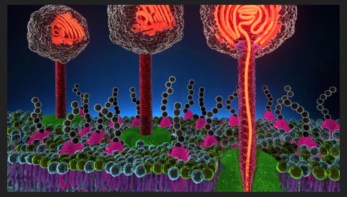
Researchers at the Helmholtz-Zentrum Berlin für Materialien und Energie (HZB) have developed a new X-ray tomography technique that’s capable of acquiring a record-breaking 1000 tomograms per second. The microscope could be used to monitor extremely fast processes in materials with high spatial resolution.
Computed tomography (CT) is a popular medical imaging tool in which a part of the body is X-rayed from all sides to produce 3D images of internal structures. The technique is also ideal for non-destructive analysis of materials. Here, intense synchrotron radiation is used to obtain micron-scale-spatial-resolution images in 3D and to monitor rapid processes and changes in a sample.
In 2019 a team of researchers led by HZB’s Francisco Garcia Moreno managed to record 200 tomograms per second using their technique, which they subsequently dubbed tomoscopy – in analogy to radioscopy. Indeed, the number of tomograms per second (tps) is the equivalent of the number of frames per second (fps) used to describe 2D X-ray image sequences.
High spatial and temporal resolution
In this latest work, Garcia Moreno and colleagues made use of the TOMCAT beamline X02DA of the Swiss Light Source at the Paul Scherrer Institute in Switzerland. The researchers placed their samples on a high-speed rotating table, developed in their lab. The angular speed of the table, which can reach 500 Hz, can be perfectly synchronized with the acquisition speed of the high-speed CMOS camera used to image each sample. They obtained the images by inserting the sample into a hollow, cylindrical boron nitride crucible in the rotation stage and heating it using two 150 W infrared lasers.
The technique, which achieves a spatial resolution of just 7.6 µm at 100 tps and 8.2 µm at 1000 tps, can take 40 2D projections of the sample in one millisecond. These projections are then stacked atop each other to create a tomogram of the sample.
To test their technique, Garcia Moreno and colleagues recorded the extremely rapid changes that occur as a sparkler is burnt (following ignition using the infrared lasers). This exothermal combustion process is technologically important and releases a huge amount of heat and a combustion wavefront moving as fast as 1–100 mm/s. This wavefront is difficult to image using conventional techniques.

Ultrafast photon detectors enable reconstruction-free medical imaging
The researchers also imaged dendrites forming in aluminium-germanium and aluminium-bismuth casting alloys as they solidify, and the growth and coalescence of bubbles in liquid aluminium-silicon-copper foams. This coalescence is an unwanted but unfortunately common process in such foams, which are interesting, lightweight materials from which future electric cars might be built.
Previous radioscopy and tomoscopy experiments revealed a film rupture time of less than 1 ms and a coalescence time (the time to form a new bubble) of 0.5–1.2 ms. Such time scales are now accessible with the temporal resolution of the new tomoscopy technique, say the researchers, and will allow for insights into the morphology, size and cross-linking of these bubbles – important factors when it comes to making mechanically strong and stiff components.
The research is detailed in Advanced Materials.



